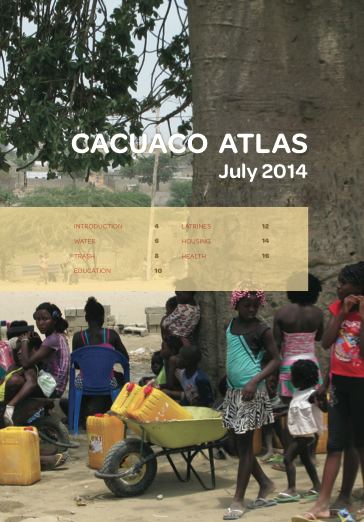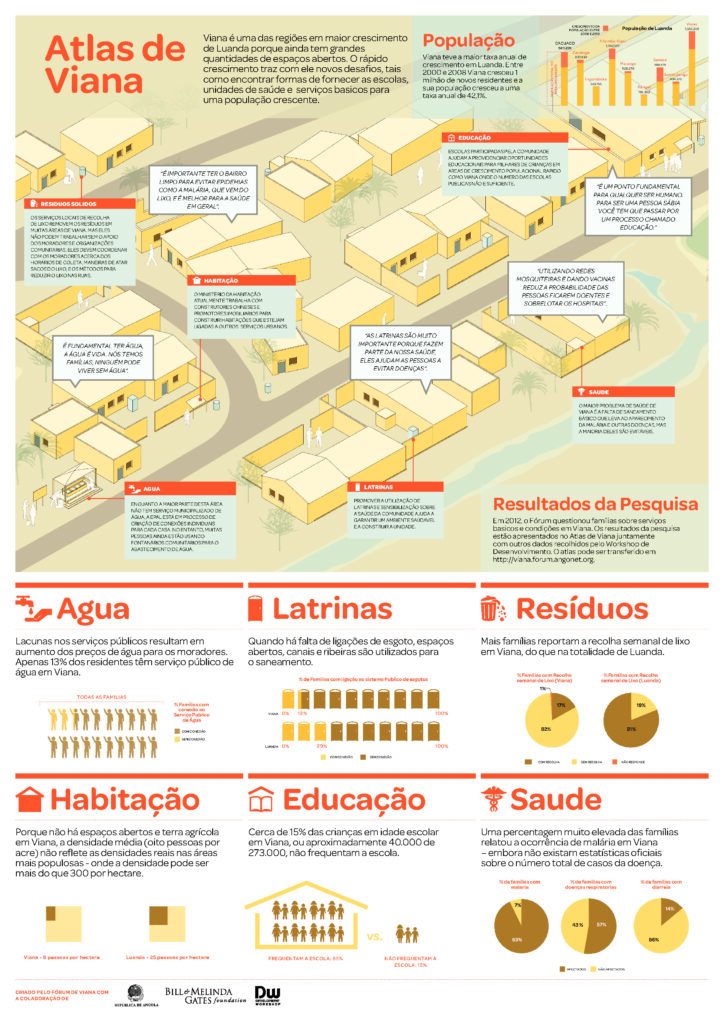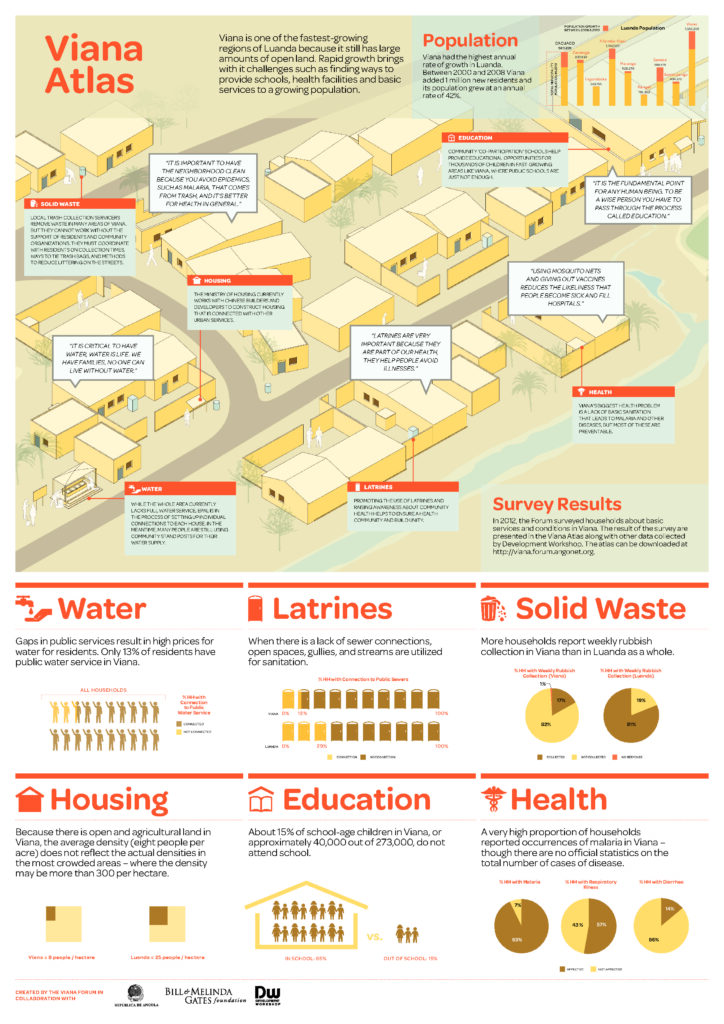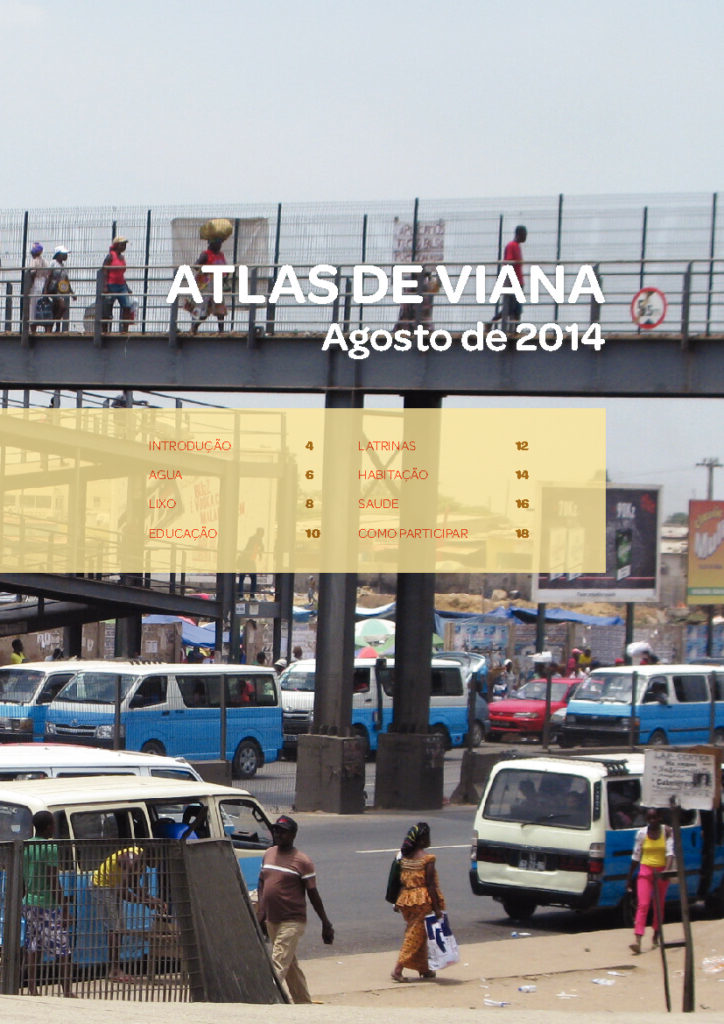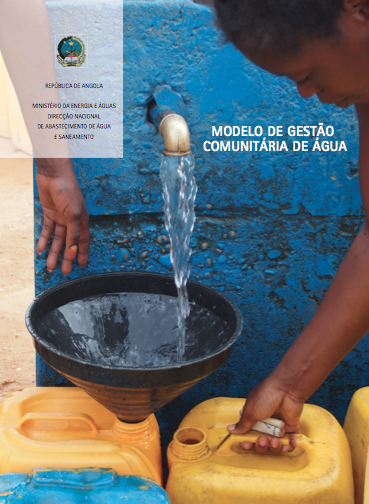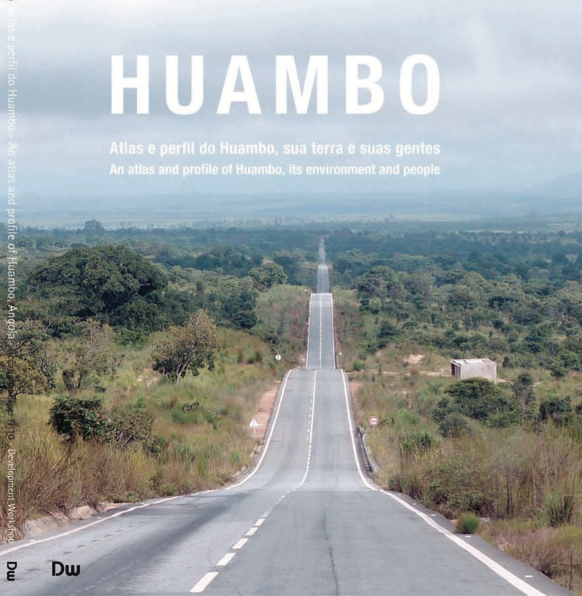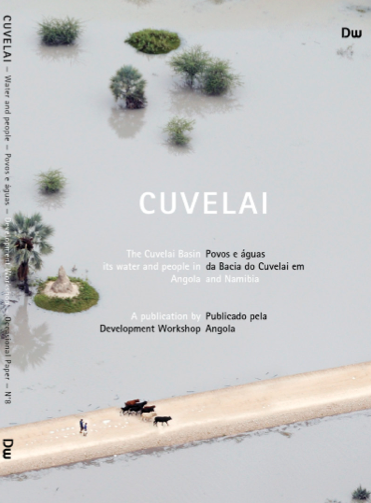Cacuaco Atlas (English)
Publication Date: August 15, 2014
Click here to view file
Viana Atlas Poster (Portuguese)
Publication Date: August 1, 2014
Click here to view file
Dois página poster PDF criado pelo Fórum Viana, em colaboração com o Governo de Angola, Bill & Melinda Gates Foundation e Development Workshop.
Viana Atlas Poster (English)
Publication Date: August 1, 2014
Click here to view file
Two page poster PDF created by the Viana Forum in collaboration with the Government of Angola, Bill & Melinda Gates Foundation and Development Workshop.
Atlas De Viana (Portuguese)
Publication Date: August 1, 2014
Click here to view file
A população de Viana cresce todos os dias pois ha mais pessoas que se deslocam para Luanda e áreas vizinhas para tentar encontrar emprego e habitação. Viana é uma das regiões de Luanda com crescimento mais rapido porque ainda tem grandes quantidades de terra desabitada. pessoas de outras partes de Luanda deslocam-se para aqui à procura de terrenos. a chegada de novas pessoas influencia a habitação disponível, a paisagem urbana e potencia riscos físicos para os moradores. A Administração municipal, os cidadãos e as organizações da sociedade civil de Viana estão a encontrar maneiras de atender a essas desafios e o Atlas de Viana partilha exemplos de maneiras pelas quais as necessidades urgentes estão a ser atendidas.
Criado pelo: Fórum Viana em colaboração com o Governo de Angola, Bill & Melinda Gates Foundation e Development Workshop.
O Modelo De Gestão Comunitária De Água
Publication Date: October 1, 2013
Click here to view file
O Modelo de Gestão Comunitária de Água – MoGeCA privilegia na sua abordagem o envolvimento dos grupos locais na negociação, construção e gestão dos pontos de água, como pressuposto básico para promover o desenvolvimento local. A gestão comunitária é aqui definida como sendo uma forma de cooperação entre a comunidade e o governo ‐ administrações locais e a Direcção Provincial de Energia e Águas (DPEA) ‐ ou empresas locais de águas, caso existam, na melhoria do abastecimento de água à população que se desenvolve num contexto particular em que cada actor desempenha uma função específica complementar.
Publicado pela: Development Workshop Angola com apoio de Direção Nacional de Abastecimento de Água e Saneamento (DNAAS)/ Ministério da Energia e Águas (MINEA), UNICEF e União Europei.
Download um PDF do material de treinamento ilustrado:
An Atlas and Profile of Huambo, Its Environment and People / O Atlas E Perfil Do Huambo, Sua Terre E Suas Gentes
Publication Date: June 1, 2013
Click here to view file
An atlas and profile of Huambo, it’s environment and people offers information essential to understand better the customs and traditions, realities and aspirations of the province’s inhabitants. This information is important and timely for all decision-makers to enable them to take appropriate steps in the planning and execution of measures appropriate to fulfilling the aspirations of the citizens of the Central Plateau.
Published by: Development Workshop with special credit for financial support to the United Nations Development Programme (UNDP) and the International Development Research Centre’s (IDRC) programme for Urban Poverty & Environment.
“O atlas e perfil do Huambo, sua terre e suas gentes” proporciona-nos informações fundamentais para melhor conhecimento dos usos e costumes, práticas e aspirações das populações que habitam a província, subsídios fundamentais e oportunos para os decisores do País e da região, tomarem as medidas adequadas na programação e execução de acções susceptíveis de assegurar um bem estar a altura das pretensões dos cidadãos do Planalto Central.
Publicado pela: Development Workshop com um agradecimento particular pelo apoio financeiro vai para o Programa das Nações Unidas para o Desen-volvimento (PNUD) e para o programa para a Pobreza Urbana & Ambiente do IDRC–International Development Research Centre (Centro Internacional de Pesquisa para o Desenvolvimento).
The Cuvelai Basin, Its Water and People in Angola and Namibia / Povos E Água Da Bacia Do Cuvelai Em Angola E Namíbia
Publication Date: January 1, 2011
Click here to view file
The Cuvelai Basin is perhaps unique in the world as a drainage system that consists of hundreds of channels that join and separate thousands of times. This is an inland drainage with no outlet to the sea. Compared to surrounding areas and much of southern Africa, the Cuvelai is home to a very large number of people, largely because of the presence of shallow groundwater and relatively fertile soils in many areas.
It is hoped that the information provided in The Cuvelai Basin, it’s water and it’s people in Angola and Namibia will allow public servants in Angola and Namibia to understand the nature and potential consequences of flooding in new ways. Likewise, members of civil society organisations, and of disaster and development agencies should have more information on which to base their planning and humanitarian work.
Published by: Development Workshop with special recognition to BP Angola and Google Earth.
Purchase: Print editions are for sale at DW’s office in Luanda.
Esta compilação de informações tem como foco a forma como correm as águas na Bacia do Cuvelai e as pessoas que aí vivem. Ambos os aspectos chamaram a atenção, recentemente, devido aos níveis acima do normal das águas e às inundações dos últimos três anos. Estradas, pontes, habitações, empresas ficaram danificadas e algumas pessoas perderam a vida nas enxurradas.
Espera-se que as informações disponibilizadas nesta publicação assim como os conjuntos de dados que foram recolhidos para o projecto venham a contribuir para que os funcionários públicos de Angola e Namíbia tenham uma nova percepção da natureza e das potenciais consequências das inundações. Do mesmo modo, membros das organizações da sociedade civil e agências de emergência e de desenvolvimento deveriam ter mais informação sobre a qual basear os seus planos e trabalho humanitário.
Publicado pela: Development Workshop com um reconhecimento especial à BP Angola e Google Earth.
Comprar: Livros estão à venda no escritório do DW.
What to Do When the Fighting Stops
Publication Date: January 1, 2006
Click here to view file
Based on two research studies carried out by Development Workshop between 2003 and 2005, this book examines what happens when the fighting stops after a prolonged and intense conflict.
There have been some remarkable short-term achievements in Angola since peace was achieved in 2002, but there are a number of longer-term risks. Returning refugees, displaced people and ex-combatants have great difficulty in re-establishing their livelihoods in rural areas. Population movements continue towards peri-urban areas of the main cities and small towns, more than outweighing the movement towards rural areas.
“Normality” does not return as soon as prolonged conflict ends. The book highlights the serious gap between peace agreements and demobilisation of combatants on the one hand, and longer term socio-economic development and new governance regimes on the other. Ironically, international aid to Angola has fallen sharply; humanitarian aid has not been transformed into assistance for the post-conflict transition. There has been relatively little support for post-conflict reconstruction strategies from the international community. Particularly lacking are strategies for rebuilding institutions that have been weakened by violent conflict. The book points out areas for improved targeting of interventions and investment. It underlines the need for international assistance for post-war transitions that will help to consolidate peace, rebuilding institutions and lay the foundations for effective development.
Published by: Development Workshop with support from the International Development Research Centre, Ottawa, Canada (IDRC), the Human Security Programme of Foreign Affairs Canada, Christian Aid London Uk, the Netherlands Institute for Southern Africa (NIZA) and the Norwegian Ministry of Foreign Affairs.
Editor: Paul Robson
Palavras Da Comunidade
Publication Date: January 1, 2005
Click here to view file
Em primeiro lugar Palavras da Comunidade destina-se ao povo da província do Huambo, como um gesto de escrever um pouco da experiência durante anos difíceis da nossa história de Angola. Milhares de pessoas viveram, ou ainda vivem, uma vida semelhante àquela relatada neste livro. Esta publicação é apenas uma pequena parte num processo mais amplo que pretende estimular indivíduos e comunidades a expressarem as suas experiências e ideias, mas também a terem acesso a informação.
Em segundo lugar destina-se às pessoas, instituições e organizações (os governantes, líderes religiosos, ONG´s, jornalistas, etc), que trabalham no planalto central e estão comprometidos em melhorar a vida desta população. Esperamos que este livro seja uma fonte de inspiração e encorajamento e que faça com que haja respostas concretas para resolver os problemas do povo do Huambo.
Por fim, o livro é destinado à todos aqueles que querem entender melhor o povo da província do Huambo, as suas tristezas e alegrias, as dificuldades e esperanças. “Que sejamos vistos como pessoas procurando querendo viver em paz, querendo melhores dias para nós, para os nossos filhos, e para a nossa nação Angola.”
Publicado pela: Development Workshop
Editor: Michael Comerford
Terra (English)
Publication Date: January 1, 2005
Click here to view file
In 27 years of civil war, millions of Angolans fled the countryside for the relative safety of the big cities and their crowded shantytowns. With their meager resources, they built dwellings on land obtained by mostly informal mechanisms, often with little security of tenure.
Based on pioneering research on urban land access in Angola by the NGO, Development Workshop, and the UK-based Centre for Environment & Human Settlements, this book argues that the so-called “anarchic” land development in Angola’s cities presents a unique opportunity to develop new approaches to post-war urban land management. The recommendations on policy and practice are grounded in Angola’s reality. Drawing on field research and recent international experience in urban land management, the themes discussed include: growth and settlement patterns in peri-urban areas, formal and informal mechanisms to access land, cultural values and perceptions about land, institutional capacity for urban land management, decision-makers attitudes and perceptions about urban development, and land policy and legislation in Angola”.
Equally important this book documents the use of action research as an advocacy tool in the drafting of the 2004 Land Law and in the associated public consultation process. The latter was the first-ever such process with broad popular participation in Angola. While the book focuses on urban land issues, these need to be seen in a wider context of changing governance in Angola, and indeed in the Sub-Saharan Africa region.
Published by: Development Workshop with financing from the Department for International Development (DFID) UK, Norwegian Foreign Ministry and Novib (OXFAM Netherlands).
Purchase: For sale at DW’s office in Luanda.

